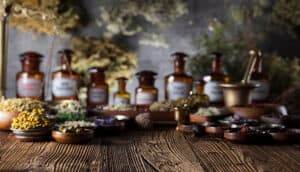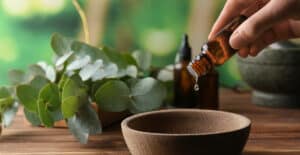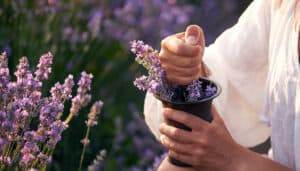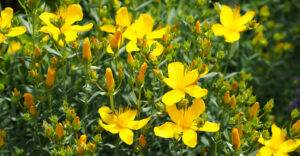The art of gardening, whether you’re growing medicinal plants or vegetables, is one of the most rewarding endeavors to embark on. With gardening, you literally harvest the “fruits of your labor” and witness the amazing journey from seed to sprout to flower to seed again.
While growing vegetables is important, growing your own medicine is equally important. Medicinal herbs are remarkable plants, and when used correctly, they can aid our health in several ways. By tending and harvesting your own medicinal herbs, you can start building your home apothecary for yourself and your family.
Next time you come down with a fever or you’re struggling with the winter blues, you’ll know exactly what to reach for. Not only is that an empowering act in and of itself, but there is also a certain indescribable comfort and connection to the plants you grow, which aids in the medicine offered by the plants.
With that in mind, let’s dive into how to grow a medicinal herb garden. I’ll walk you through everything you need to know to get started, practical tips to help your garden thrive, and my favorite, easy medicinals to grow. All the methods I share with you are with the health of the land, and the health of the people in mind, so I strongly encourage organic gardening methods without synthetic (or organic!) herbicides or pesticides.
Let’s get started.
How to Grow A Medicinal Herb Garden
Step 1: Planning Your Medicinal Herb Garden
Before you put your hands in the dirt, it’s important to do some initial planning for your garden. It’s also helpful to understand why you want a medicinal herb garden. Set an intention for your garden, whether spiritual or practical or both.
For example, maybe you want your medicinal herb garden to be a sanctuary of peace, meditation, and beauty. For that, you’ll want to design a place to sit and admire the flowers and lovely pollinators.
Perhaps you want an herb garden for your kitchen and family. In this case, you’ll want the garden close enough to the home so it’s easy to run out and grab some fresh herbs while you’re cooking. Maybe you’re a budding herbalist and want hands-on experience with the herbs you’re learning about. Ultimately, these are just some ideas to help you get started, but you’ll know for yourself why you want a medicinal herb garden and what that space will mean to you.
Setting an initial intention will help you plan the space according to your desires. Plus, it’s helpful to have a clear intention and purpose for your garden because gardening is hard work. Let’s face it – there may be some days when you feel overwhelmed, tired, or discouraged, and it’s in those moments you can remember your intention and why you wanted to garden in the first place.
Evaluate Your Space
Now that you have an intention for your medicinal herb garden, you’ll want to evaluate the space you have to work with. The good news is that you don’t need a lot of space to grow a medicinal herb garden! Even if all you have is a porch and some containers, you can reap a substantial harvest.
Here are some questions to help you get started:
- Do you have raised beds to plant in? Are you planning on building raised beds? Are you planning on planting seeds straight into the ground?
- Do you already have a designated space, or do you need to plan where the garden will be? You’ll want to ensure you place your garden where it receives plenty of sunshine and isn’t too far away from the house. You’ll also want to consider how easy it will be to transport materials (compost and soil bags, wheelbarrow, etc.) to your garden.
Designing your garden can be a truly creative and exciting process, as the design possibilities are endless! You can also draw it out on a piece of paper to help you plan your design.
Don’t be afraid to use resources from the land if they’re available to you! For example, we had a lot of large loose rocks in our field and around our home that my husband and I used to build a long rock berm, which turned into a beautiful and whimsical addition to our garden.
When you know how much space you have to work with, you can realistically plan how many plants you would like to grow.
If you’re a beginner gardener, I would suggest starting small, even if you have a large space to work with. I know all too well how exciting it is to plan your garden in February with the last grips of winter clinging on. During that time, it’s wonderful to imagine a large beautiful garden full of blooming flowers and buzzing insects.
However, a large garden requires a lot of initial and consistent work. If you’re the only one gardening and you won’t have much help, go easy on yourself and start with what you can realistically manage.
Pick the Medicinal Herbs You Want to Grow
This is my favorite part of planning a medicinal herb garden. Picking out the seeds and starts for my garden is like knowing I’ll get to meet a new friend who will become dear to my heart over the coming months.
If you don’t already know the medicinals you wish to grow, it’s helpful to think about what medicinal plants will benefit you the most. For example, you could ask yourself, “what are the most common needs/ailments I have or that my family has?” “What herbs am I most drawn to?”
For me, my nervous system has needed a lot of support, so I’ve grown herbal nervines such as lemon balm, mugwort, chamomile, and holy basil. I’m also drawn to the cheery medicine of Calendula, which I drink in an herbal infusion almost daily.
For this step, it may be helpful to write a list of all the herbs you would like to grow (even if you don’t plan on growing all of them this season). Then, you can go through the list and do some preliminary research on each plant’s USDA hardiness zone and growing requirements. That way, you can cross plants off your list that may not be able to grow in your area or you don’t have the right growing requirements for.
Next, you’ll want to decide if you plan on growing those herbs from seed or purchasing starts from a local nursery. Local nurseries may or may not sell medicinal herb starts, so you’ll want to do some research to see what’s available to you. I would suggest only planting straight medicinal species over cultivars, as most cultivars are less medicinal than the straight species, except for rose and raspberry.
If you plan on starting your herbs from seed, you’ll want to research each herb’s germination requirements. While most medicinal herbs are easy to grow, they are a bit more particular about their germination than vegetable seeds.
For example, many medicinal herbs benefit from (or require) a period of cold, moist stratification. Stratification is the process of mimicking a seed’s life cycle in the wild. A simple way to do this at home is to mix the seeds with a little bit of damp play sand and place it in the fridge for the required time. Alternatively, you can plant seeds in the fall in the spot you wish for them to grow.
Some plants, like lemon balm and mugwort, only require about two weeks of stratification, while others may need a few months. Furthermore, some herbs, such as woodland medicinals, require a cold, moist stratification period followed by a warm, moist stratification period. For this reason, it’s best to research each herb’s germination requirements.
The most important thing is to understand the growing requirements and characteristics of the medicinals you wish to grow. That way, you can strategically plan where each herb will go, such as taller herbs in the back of the garden or shade-loving plants underneath taller, vining plants.
You’ll also want to make note of which herbs are perennials, self-sowing annuals, and which herbs will die back each year. That way, you can decide where each perennial or self-sowing annual’s “forever home” will be. I would suggest planting herbs intermixed rather than in separate rows (the benefits of this will be explored more in-depth below).
Step 2: Prepare Your Garden For Medicinal Herbs
Time to get your hands dirty! The next step in growing a medicinal herb garden is to prep the soil for seeds and/or starts. To do this, you’ll want to learn more about your soil, including what type of soil you have, the pH level, and what the nitrogen (N), phosphate (P), and potassium (K) levels are.
Soil Types
While there are many different types of soil and combinations of soil types, we generally define them into four types: fertile, clay, silty, and sandy. Knowing what kind of soil you’re working with will help you know what kind of amendments and organic matter you might need to add.
Fertile soil generally doesn’t require many amendments and is soft, crumbly, and dark with copious organic matter and good tilth. Tilth describes the quality of soil and refers to soils with a stable, porous structure to allow for ample air and water circulation and nutrient flow.
You can tell if you have clay soil if the soil is red, reddish brown, or brownish gray. If you have olive/gray soil, that also indicates a high clay content along with silty materials. Clay soils hold their form when moist and handled; you can pitch it and roll it in your hand, and it will keep its shape. Because of how thick and dense clay soils are, it’s hard for plants to deepen their roots and receive enough air circulation. You can amend clay soils by adding organic matter, such as compost and pine bark fines, as well as planting cover crops that help break up the soil, such as burdock and alfalfa.
Silty soils are loose, soft, and grey and usually come from a floodplain or river bottom. Because of how loose the soil is, it can easily erode. Because of this, you’ll want to add organic matter and some clay to help improve the stability of the soil (tilth).
Sandy soils are easy to distinguish; they are light in both color and feel, extremely loose, and will easily sift through your fingers when held. The difference between silty and sandy soils is that silty soils are usually a bit denser and can hold water better than sandy soils. Sandy soils don’t hold water well, and it’s hard for plant roots to take hold of the loose sand grains. If you have sandy soils, you’ll want to add an abundance of organic matter (compost, pine bark fines, animal manures) and clay.
Soil Tests
While getting a soil test isn’t absolutely necessary to grow a medicinal herb garden, it will help you learn about the nutrients (nitrogen, phosphorous, potassium) in your soil and what amendments you should add. You can purchase an at-home soil test, or you can have an in-depth (super accurate) test done by your local extension office.
A soil test will also provide the pH level of your soil, which describes how acidic or alkaline the soil is. If your soil’s pH level is extremely alkaline or acidic, it could affect nutrient availability, which would result in languishing plants. You want your soil to have an average or near-neutral pH level (6.8 to 7.2). However, each medicinal herb has its own pH preference, and most herbs will tolerate a range in the soil pH.
Prepare Your Garden Beds
If you’re filling raised garden beds, you’ll want to mix organic potting soil with organic matter, such as compost, composted animal manure, and/or pine bark fines. If you would like to make your own potting mix, there are several recipes you can find online.
If you want to plant straight into the ground, you’ll need to assess if you need to till or not. Tilling isn’t the preferred method of preparing a garden bed because it disturbs the ecosystem of the soil, including beneficial soil microbes and mycelium. However, if you’re working with compacted dirt, you may need to loosen the soil first and mix in organic potting soil, compost, and pine bark fines. You can loosen the soil with a walk-behind tiller or by hand with a shovel or broadfork.
From my experience, shovel work does a better job of preparing the soil than a tiller, but it is much more time and labor-intensive.
Tilling should only be done initially to establish a new garden bed. Thereafter, the soil should be cared for with cover crops and yearly additions of compost. Tilling an area every year will do more harm than good, as it disrupts the soil’s ecosystem which contributes to happy and healthy plants.
Step 3: Plant Your Medicinal Herbs
Once your garden beds are prepared, they’re ready for your precious seedlings! You’ll want to decide if you want to start your seeds indoors beforehand or plant directly into the soil. This decision is largely based on your preferences and the medicinal herb in question. Some plants do better in seed trays, while others have no problem coming up on their own.
If you start the seeds indoors, you’ll want to make sure they get plenty of direct light, airflow, and bottom heat. Use a mist sprayer or mist spray bottle to water them, as most medicinal seeds are tiny and are light-dependent germinators, so they’ll need to be on the surface of the soil. Keep the soil evenly and consistently moist but not water-logged.
Cover Garden Beds with Mulch
After planting your starts, you’ll want to cover the garden bed in mulch, leaving about a 1-inch diameter around the base of each plant. Mulch is your garden’s best friend for several reasons; It keeps the soil moist and cool during hot summer days, suppresses weeds, prevents dirt and soil-based pathogens from splashing up onto your plants, and sends a slow-release of nutrients into the soil (based on what kind of mulch you use).
There are several types of mulch you can use, including hay, straw, wood bark, raked leaves, and grass clippings. I would avoid using plastic mulches as they don’t provide beneficial nutrients to the soil and may release toxic chemicals into the earth (such as phthalates).
I prefer to use fresh grass clippings as mulch around my herbs and vegetables as it’s readily available, free, and adds wonderful nutrients into the soil as it breaks down. The downside is that it does break down quickly, so it needs to be re-applied a few times throughout the growing season.
Another downside to mulch is that it can harbor slugs. This is especially the case with straw mulch. If you have a slug problem in your area, I wouldn’t recommend mulching around plants that the slugs love, such as calendula, lemon balm, spilanthes, elecampane, and anise hyssop.
Plant Diversity for A Healthy Ecosystem
One of the premises of permaculture is to create an ecosystem that is diverse and self-sustaining. One of the ways to do this is to strategically intermix and place your plants where they will benefit one another.
Planting diversly supports the entirety of your garden and each plant for several reasons. Most importantly, it limits the spread of pests and diseases and creates resilience to stress.
I’ve had experience with both methods of gardening: planting one large crop and intermixing plants. One year, I had two large garden beds with just calendula. While I reaped a substantial harvest and the beds looked beautiful, they were hit hard with powdery mildew. The following year, I planted yarrow, borage, chamomile, and calendula in the same beds. The powdery mildew was noticeably less and didn’t seem to spread as quickly as the year before. Plus, the plants were more vital, and the diverse arrangement of flowers attracted more pollinators.
Another benefit of intermixing medicinal herbs is that one plant can serve multiple functions, which is another component of permaculture. For example, yarrow serves the garden by attracting pollinators and predatory insects, is a dynamic accumulator, and is an aromatic pest confuser. A dynamic accumulator is a plant that “mines” nutrients from the soil and concentrates those nutrients (nitrogen, potassium, phosphorus, calcium, etc.) in its leaves. When the plant drops its leaves, it releases those nutrients back into the soil, feeding the other plants nearby.
By intermixing and strategically planting your herbs, you can provide resilience and vitality to your garden. There’s much more I can add here, too much for this article alone, so I encourage you to do further research on medicinal herb companion plants, nitrogen-fixers, dynamic accumulators, and permaculture.
Step 4: Tend your Medicinal Herb Garden
Tending a medicinal herb garden consists of regular watering, weeding, and checking for any signs of disease or pests. The amount of watering you need to do largely depends on the climate you live in. That said, all you need to do is stick a finger in the soil to test the moisture level. A sure sign to water is if the moisture level is down further than the tip of your finger – I usually water if the moisture level is about at the tip of my finger. You want your plants to stay consistently watered, but you don’t want to water-log them. Seedlings and starts will require more watering than mature, established plants.
Herbalist and avid gardener Juliet Blankespoor suggests making yourself a cup of tea in the morning and giving your garden a thorough walk-through for any diseases. If you find any, you’ll want to cut away the diseased portion, even the whole plant if needed, which will keep the disease from spreading.
Some medicinals, such as anise hyssop and holy basil, benefit from “pinching back,” which is the act of removing the young buds and growth from the ends of plants. This helps the plant produce more foliage and “bush” out.
Fertilizing
When your plants are young, and occasionally throughout the growing season, you can fertilize them by giving them a side-dressing or a foliar feed. Foliar feeding is spraying the leaves of your young starts and mature plants with diluted fertilizer rather than applying the fertilizer at the base of the plant.
For either method, you’ll want to do your research on application methods and how much you should dilute the fertilizer. My favorite fertilizer for both applications is organic liquid fish emulsion. I find that young medicinal herb seedlings are especially appreciative of the little “energy boost” they receive from foliar feeds.
Fertilizing may not be necessary if you have fertile soils with abundant nutrient availability. A soil test will help you determine what kind of fertilizer would be most beneficial for your plants. You don’t want to over-fertilize, but a little help here and there encourages robust plant growth and fruit/flower production.
Get to Know Each Plant and Their Individual Needs
The best way you can tend your medicinal herb garden is to research the siting and garden care for each of your herbs. Every plant is slightly different in what kind of care it prefers. While some plants can be left alone to do their thing, others need a bit more attention. It all depends on the medicinals you plan to grow.
Step 5: Harvest Your Medicinal Herbs
After a month or so of tending and caring for your medicinal plants, you can start the wonderful process of harvesting and processing your herbs. Understanding each herb’s uses and what plant parts are used is critical, as you want to harvest the proper parts of the plant when it is most medicinally active. Essentially, each herb is going to have different harvesting requirements and the time of year that it should be harvested. Furthermore, some herbs may be harvested once in the growing season, while others are a continual harvest.
Chamomile, calendula, and rose are examples of medicinal flowers that are harvested multiple times throughout the growing season. Root medicines are only harvested once, such as marshmallow, which is harvested in the fall of its second year. Plants like holy basil and gotu kola can be harvested two to three times throughout the growing season with the “haircut method” (as herbalist Juliet Blankespoor describes it), which is when their aboveground parts are cut down to their base. After this initial cut, the plant will send out a flush of new growth.
I would encourage you to purchase an herbal gardening book that shares harvesting and growing methods for medicinal herbs. That way, you’re well prepared when harvesting season comes around!
Drying Herbs
You can dry medicinal herbs on screens, in hanging baskets, in a dehydrator, or bundles hung from a string. The most important factor for your drying space is warmth, dryness, air ventilation, and lack of sunlight (you don’t want direct light hitting your herbs). If you live in a humid climate, you might want to consider investing in a dehumidifier or dehydrator.
You want to ensure your plants are thoroughly dry before storing them in glass containers. If not thoroughly dry, they can mold and would need to be thrown out.
For leaves and flowers, you can test their dryness by crumbling them in your fingers. If they crumble easily, then they’re fully dry. If they have some give to them and still bend slightly before crumbing, then they’re not thoroughly dry.
With rose petals, however, they will never get “crispy” and will always have a bend to them even when fully dried.
You can store dried herbs in air-tight glass containers, such as canning jars.
Tincturing Herbs
With some medicinals, you’ll want to prepare them immediately after harvesting as a fresh tincture. The easiest way to describe how to make a tincture is to fill a glass jar with chopped plant material and then cover the plant material with alcohol until it’s completely submerged. You then let the tincture sit for a few weeks, shaking occasionally, and then strain out.
To be more exact, you can use a weight-to-volume ratio, usually seen as 1:2 or 1:4, which means for every 1 ounce of the herb by weight, you would add 2 fluid ounces of alcohol (volume). The percentage of alcohol used depends on the herb you’re extracting, as some medicinals require a higher percentage of alcohol (95%) while others require a lower alcohol percentage (50%).
The advantage of tinctures is that they concentrate the medicine, so you can take less of the herb but still receive a substantial dose. They’re also extremely easy to administer and are the preferred method of taking unpalatable herbs, such as motherwort or Oregon grape root.
Step 6: End of Harvest – Cover Crops
After your medicinal annuals and vegetables have died back, you can prepare the garden for next year’s growth by planting cover crops and adding another layer of compost. Cover crops help build soil fertility, suppress weeds, and add nitrogen to the soil. Cover crops are usually planted in the fall or early spring and can be worked back into the soil as “green manure.”
Examples of cover crops include:
- Red clover (Trifolium pratense)
- White clover (Trifolium repens)
- Alfalfa (Medicago sativa)
- Milky Oats (Avena sativa)
- Common Vetch (Vicia sativa)
5 of My Favorite and Easiest Medicinal Herbs to Grow
- Calendula (Calendula officinalis)
Calendula is a wonderful addition to the medicinal herb garden as it’s incredibly easy to grow and produces these beautiful, orange, sunny flowers. Calendula is an annual that can be grown in any zone. It prefers full sun but will tolerate light shade and prefers fertile, well-drained soil. That said, it isn’t too picky and will grow in a variety of soil types and conditions!
Direct-sow calendula seeds in mid-spring, about ¼ inch deep and 1 foot apart. It has a high germination rate and will germinate in about seven to fourteen days. Alternatively, you can start calendula indoors, and transplant starts once they bear a couple of true leaves. The latter is recommended if you have a lot of slugs, your springs are cold, or you have deer passing by. They love munching on little calendula seedlings!
You can harvest calendula as soon as it starts flowering, and you want to harvest the full flower head, not just the petals. The green, resinous base of the flower head is where all the medicinal goodness lives. Harvest when the sun is at its peak, around midday.
The wonderful thing about calendula is that the more you pick, the more it flowers! You can harvest calendula throughout the growing season. I usually slow down or stop harvesting towards the end of the season when most of the flowers are smaller and less vibrant than they were at the beginning of the season. You also want to let some vibrant and large flower heads go to seed if you wish to collect the seed.
Calendula happily self-sows and will return year after year if you allow the seed heads to fall and don’t mulch heavily. It can start to spread, but it isn’t an exuberant spreader. Wayward calendula starts can easily be pulled, transplanted, or thrown into the compost!
- Skullcap (Scutellaria lateriflora)
Skullcap is a small herbaceous perennial that is dear to my heart. I treasure its medicine, and it has the most darling little purple flowers and dark green leaves. It likes its feet wet, so you’ll want to place it in an area that receives a lot of moisture. You’ll find it growing naturally along open streambanks, wet meadows, and marshes.
Skullcap does well with partial shade. It will tolerate full sun in cooler climates but will need shade cover in hot, dry climates. If you live in an arid climate, consider growing skullcap in a container where you can control the moisture content better.
The seeds need to be stratified for about two months before direct-sown after the last frost or sown in seed trays. You can use the refrigerator method for the stratification period or plant them directly in the garden in the fall. Lightly push the seeds into the soil and cover them with a thin layer of soil. Skullcap can also be successfully propagated from root division.
Skullcap prefers fertile soil with generous organic matter. Space plants about a foot apart. Skullcap spreads by runners, so be aware that it will eventually form a colony wherever you place it. Keep this in mind so that you can place it somewhere in the garden where you don’t mind it spreading. If it spreads farther than where you want it, you can easily pull up the wayward starts.
Harvest the aboveground parts when in flower and dry on racks or immediately prepare as a tincture.
- Holy Basil/Tulsi (Ocimum tenuiflorum)
I adore growing holy basil as a medicinal herb and a culinary delight. The easiest holy basil variety to grow is ‘Kapoor,’ also called ‘temperate.’ I think this variety has a lovely smell and taste; it isn’t too powerful or spicy, making it a wonderful addition to a pesto recipe.
Holy basil is an annual in temperate zones and grows as a perennial in zones 9-11. In cooler climates, it prefers full sun and fertile, well-drained soil. It likes to stay consistently moist but not water-logged.
The seeds need warm temperatures to germinate, between 70-85℉. Because of this, I prefer to start my seeds in trays indoors with bottom heat. Shallowly sow the seeds and barely cover them with soil; germinates in about 5 to 21 days. Direct sow or transplant starts after the danger of frost has passed and space about 1 foot apart.
Holy basil is prone to flower early, forming buds even as a little plant. To encourage more vegetative growth, pinch back the buds and new growth. Pinching back will need to be done periodically in its first month of growth.
You can harvest holy basil when it’s in flower using the “haircut method.” It will quickly grow back, and you may be able to get a few harvests in throughout the growing season.
- Lemon Balm (Melissa officinalis)
Lemon balm was one of the first medicinal herbs I became acquainted with. Its divine lemony flavor and uplifting nature soon captured my heart, and I have been devoted to it ever since. It is one of my most-used and well-loved medicinals.
Lemon balm is an herbaceous perennial that prefers rich, moist soils but will tolerate dry or sandy soils. It does well in both full sun and partial shade. Lemon Balm benefits from two weeks of stratification. While a stratification period isn’t necessary for this hardy plant, it will have a better germination rate if stratified. As a light-dependent germinator, it should be sown on the surface of the soil and barely covered. You can direct sow in the garden after the danger of frost has passed or start it indoors in seed trays. It germinates in about seven to fourteen days.
Space lemon balm about one to two feet apart. It will bush out as it ages, and it has a tendency to spread. You can apply the “haircut method” to lemon balm and reap two to three harvests throughout the growing season. If you don’t want it to spread (as it will happily do so), cut back the flowering tops before they go to seed.
- Yarrow (Achillea millefolium)
Yarrow is one of the best first-aid and versatile medicinal herbs to have in your home apothecary. It is also extremely easy to grow, doesn’t require much maintenance, and greatly benefits the garden.
Yarrow is an herbaceous perennial native to North America and can be found growing in a variety of soil types. Because of this, it isn’t too picky and can tolerate average to poor garden soil. Some herbalists suggest not “pampering” yarrow with frequent watering or fertile soils, as yarrow grown in poor soils and harsher conditions is more medicinally potent. It prefers full sun and well-drained soils and is drought-tolerant.
Yarrow can be direct sown in early spring or started in seed trays several weeks before the last frost. It’s a light-dependent germinator; sow seeds on the surface of the soil. Expect gerimation in about ten to fourteen days. It can also be propagated from root divisions. Space plants about twelve inches apart. It likes to form dense colonies, so make sure to give it room to spread.
The leaves and flowers are harvested for medicine. They can be dried for later use or prepared fresh as a tincture or poultice.
Grow a Medicinal Herb Garden of Your Own
I hope this guide has given you the knowledge and inspiration to start your very own medicinal herb garden! Growing your own medicine is truly one of the most empowering and rewarding experiences.
While I have given you plenty of tools to get started, true knowledge begins with experience. The only way to truly know how to grow a medicinal herb garden is to just start gardening!
With that, may you have the courage to go out, get your hands dirty, and grow lovely medicinals for your home and family.






